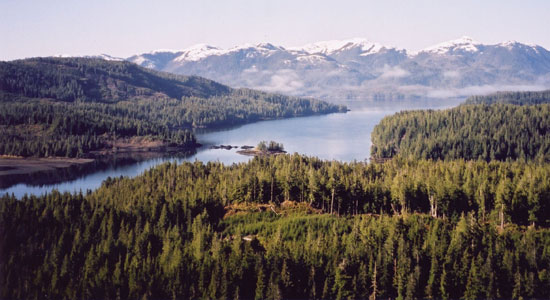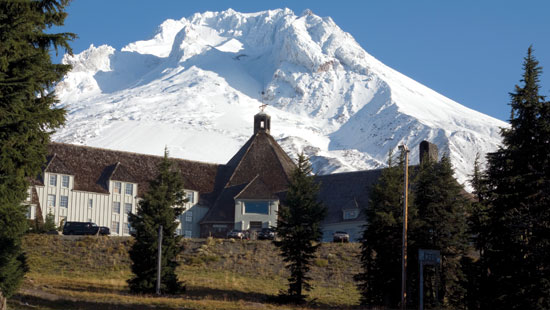Natural Winner: Western Red Cedar and Nonresidential Building
Sustainability: Supply and Resources
Sustainability was another major consideration for Sandy High School, as it is with many projects that employ western red cedar. The architects had designed a number of LEED Gold high schools, including one meeting the criteria for the Living Building Challenge, a rigorous performance standard created by the International Living Future Institute. The firm—which works out of LEED Platinum office interiors it designed in Portland, Oregon's historic Federal Reserve Building—is known for its sustainability action plan and for efficient, green works.
Resource Extraction
Considering the environmental benefits of western red cedar begins with a look at material sources and extraction costs. According to WRCLA, “America grows 30 percent more wood each year than it harvests and has more forestland today than 100 years ago.” Mackie adds that the renewable material comes almost exclusively from “sustainably and responsibly managed forests” primarily in British Columbia, with a considerably smaller fraction from Idaho and Northern Oregon. While there is a harvest in Washington State, says Mackie, that stock is almost entirely used for fence boards.
“About 95 percent of the forestland in British Columbia is owned by the province and operated under management contracts—tree farm licenses, or TFLs—for large blocks of timberland,” says Mackie. “Of those forests, more than 85 percent of the operations are third-party certified as sustainably managed.” About two-thirds of the forests are certified by the Canadian Standards Association (CSA) Group Sustainable Forest Management (SFM) System. Of the remaining third, most is certified by the Sustainable Forestry Initiative (SFI) with a small slice of about 5 million acres (2 million hectares) certified by the FSC, the Forest Stewardship Council.
Summing up, Canadian western red cedar sourced for a building project is very likely to be certified; in the United States, certified product is also readily available. Overall, only a sliver of the lands are harvested on an annual basis—in Canada, less than 0.33 percent—and, says Mackie, “Forests are replanted immediately and replanted in kind, meaning that they have to replant exactly the same proportion and mix that came off the land, and the same way it flourished.” Western red cedar thrives in the shade and also grows on mountains and riverbanks, yet in the coastal forests of British Columbia it may account for only about 25 percent of the species mix. On Vancouver Island, for example, the timber stand is about 60 percent western hemlock, and the balance divided evenly between fir and western red cedar.
 |
About two-thirds of the forests producing western red cedar are certified by the Canadian Standards Association, and most of the rest are certified by other organizations. Less than one-third of 1 percent of the lands are harvested annually. Photo courtesy of WRCLA |
Forest Management
Forest management and harvesting practices have advanced significantly, according to the CSA, which says it certifies more forestland than any other group. CSA released the SFM standard in 1996, and it is promoted through the Program for the Endorsement of Forest Certification, or PEFC. Certified lands must follow six criteria, including:
• Recognition of environmental, economic, social, and cultural values.
• Conservation of biological diversity.
• Ongoing public participation.
For specifiers and buyers of western red cedar, this means significant advances in management practices and harvesting. For example, the average cut block is relatively small, at about 50 acres (20 hectares), and replanted in kind. Using variable retention techniques, forest operators leave clumps of trees across cut areas to provide corridors for habitat and to help prevent erosion. For steep mountainside cuts, most logging companies use helicopters for extraction rather than build roads, which are costly—in some cases, $1 million per mile—and cause soil disturbance and erosion.
 |
The “Sandy Style” municipal design standard used in Sandy, Oregon, is based on the regional Cascadian architectural style, epitomized by the Timberline Lodge. Photo by Jon Tullis/Timberline Lodge |
Best practices in replanting are also employed to promote biological diversity and environmental balance. In addition, newly planted saplings of two to four years old are protected with a wire-mesh cage to prevent deer and elk from damaging the tender, delicate foliage. Protections for social and cultural values include protecting any mature cedar tree or stand that is culturally modified, meaning for example that bark has been stripped for basketry or clothing, or if the tree is deemed a religious artifact. Because the native tribes are using the trees, the area is set aside, with a buffer left around the zone with evidence of cultural use. Similarly, key species are protected with a buffer; so if a bear den is found, for example, the area is protected.









